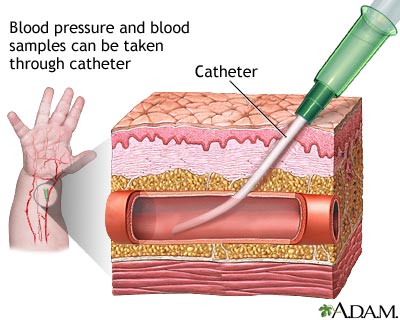Peripheral arterial line - infants
PAL - infants; Art line - infants; Arterial line - neonatal
Images

I Would Like to Learn About:
Information
A peripheral arterial line (PAL) is a tiny, short, flexible catheter that is put through the skin into an artery of the arm or leg. Health care providers sometimes call it an "art line" or "a pal." This article addresses PALs in babies.
WHY IS A PAL USED?
Providers use a PAL to watch your baby's blood pressure. A PAL can also be used to take frequent blood samples, rather than having to draw blood from a baby repeatedly. A PAL is often needed if a baby has:
- Severe lung and/or heart disease and is on a ventilator and/or other life support (for example, ECMO)
- Low blood pressure requiring medicine
- Prolonged illness or immaturity requiring frequent blood tests
HOW IS A PAL PLACED?
First, the provider cleans the baby's skin with a germ-killing medicine (antiseptic). Then the small catheter is put into the artery. The PAL is then connected to an IV fluid bag and blood pressure monitor.
WHAT ARE THE RISKS OF A PAL?
Risks include:
- The greatest risk is that the PAL can stop blood from going to the hand or foot. Testing before the PAL is placed can prevent this complication in most cases. The NICU nurses will carefully watch your baby for this problem.
- PALs have a greater risk for bleeding than standard IVs.
- There is a small risk for infection, but it is lower than the risk from a standard IV.
References
Centers for Disease Control and Prevention website. 2017 Recommendations on use of chlorhexidine-impregnated dressings for prevention of intravascular catheter-related infections: an update to the 2011 guidelines for the prevention of intravascular catheter-related infections from the Centers for Disease Control and Prevention. www.cdc.gov/infectioncontrol/pdf/guidelines/c-i-dressings-H.pdf. Updated July 17, 2017. Accessed January 25, 2022.
Edwards LR, Malone MP, Prodhan P, Schexnayder SM. Pediatric vascular access and centeses. In: Zimmerman JJ, Clark RSB, Fuhrman BP, et al, eds. Fuhrman and Zimmerman's Pediatric Critical Care. 6th ed. Philadelphia, PA: Elsevier; 2022:chap 14.
Santillanes G, Claudius I. Pediatric vascular access and blood sampling techniques. In: Roberts JR, Custalow CB, Thomsen TW, eds. Roberts and Hedges' Clinical Procedures in Emergency Medicine and Acute Care. 7th ed. Philadelphia, PA: Elsevier; 2019:chap 19.
Stork EK. Therapy for cardiorespiratory failure in the neonate. In: Martin RJ, Fanaroff AA, Walsh MC, eds. Fanaroff and Martin's Neonatal-Perinatal Medicine: Diseases of the Fetus and Infant. 11th ed. Philadelphia, PA: Elsevier; 2020:chap 70.
BACK TO TOPReview Date: 11/9/2021
Reviewed By: Kimberly G. Lee, MD, MSc, IBCLC, Clinical Professor of Pediatrics, Division of Neonatology, Medical University of South Carolina, Charleston, SC. Review provided by VeriMed Healthcare Network. Also reviewed by David Zieve, MD, MHA, Medical Director, Brenda Conaway, Editorial Director, and the A.D.A.M. Editorial team.

Health Content Provider
06/01/2025
|
A.D.A.M., Inc. is accredited by URAC, for Health Content Provider (www.urac.org). URAC's accreditation program is an independent audit to verify that A.D.A.M. follows rigorous standards of quality and accountability. A.D.A.M. is among the first to achieve this important distinction for online health information and services. Learn more about A.D.A.M.'s editorial policy, editorial process and privacy policy. A.D.A.M. is also a founding member of Hi-Ethics. This site complied with the HONcode standard for trustworthy health information from 1995 to 2022, after which HON (Health On the Net, a not-for-profit organization that promoted transparent and reliable health information online) was discontinued. |
The information provided herein should not be used during any medical emergency or for the diagnosis or treatment of any medical condition. A licensed medical professional should be consulted for diagnosis and treatment of any and all medical conditions. Links to other sites are provided for information only -- they do not constitute endorsements of those other sites. © 1997- 2024 A.D.A.M., a business unit of Ebix, Inc. Any duplication or distribution of the information contained herein is strictly prohibited.
